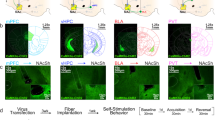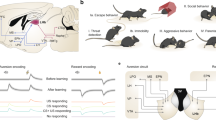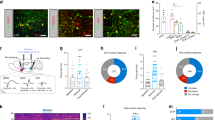Abstract
The brain reward circuit has a central role in reinforcing behaviors that are rewarding and preventing behaviors that lead to punishment. Recent work has shown that the lateral habenula is an important part of the reward circuit by providing 'negative value' signals to the dopaminergic and serotonergic systems. Studies have also suggested that dysfunction of the lateral habenula is associated with psychiatric disorders, including major depression. Here, we discuss insights gained from neuronal recordings in monkeys regarding how the lateral habenula processes reward-related information. We then highlight recent optogenetic experiments in rodents addressing normal and abnormal functions of the habenula. Finally, we discuss how deregulation of the lateral habenula may be involved in depressive behaviors.
This is a preview of subscription content, access via your institution
Access options
Subscribe to this journal
Receive 12 print issues and online access
$209.00 per year
only $17.42 per issue
Buy this article
- Purchase on Springer Link
- Instant access to full article PDF
Prices may be subject to local taxes which are calculated during checkout




Similar content being viewed by others
References
Wise, R.A. Dopamine, learning and motivation. Nat. Rev. Neurosci. 5, 483–494 (2004).
Russo, S.J. & Nestler, E.J. The brain reward circuitry in mood disorders. Nat. Rev. Neurosci. 14, 609–625 (2013).
Cools, R., Nakamura, K. & Daw, N.D. Serotonin and dopamine: unifying affective, activational, and decision functions. Neuropsychopharmacology 36, 98–113 (2011).
Stephenson-Jones, M., Floros, O., Robertson, B. & Grillner, S. Evolutionary conservation of the habenular nuclei and their circuitry controlling the dopamine and 5-hydroxytryptophan (5-HT) systems. Proc. Natl. Acad. Sci. USA 109, 164–173 (2012).
Sutherland, R.J. The dorsal diencephalic conduction system: a review of the anatomy and functions of the habenular complex. Neurosci. Biobehav. Rev. 6, 1–13 (1982).
Wise, R.A. Forebrain substrates of reward and motivation. J. Comp. Neurol. 493, 115–121 (2005).
Hikosaka, O. The habenula: from stress evasion to value-based decision-making. Nat. Rev. Neurosci. 11, 503–513 (2010).
Cools, R., Roberts, A.C. & Robbins, T.W. Serotoninergic regulation of emotional and behavioural control processes. Trends Cogn. Sci. 12, 31–40 (2008).
Lecourtier, L. & Kelly, P.H. A conductor hidden in the orchestra? Role of the habenular complex in monoamine transmission and cognition. Neurosci. Biobehav. Rev. 31, 658–672 (2007).
Omelchenko, N., Bell, R. & Sesack, S.R. Lateral habenula projections to dopamine and GABA neurons in the rat ventral tegmental area. Eur. J. Neurosci. 30, 1239–1250 (2009).
Herkenham, M. & Nauta, W.J. Efferent connections of the habenular nuclei in the rat. J. Comp. Neurol. 187, 19–47 (1979).
Jhou, T.C., Fields, H.L., Baxter, M.G., Saper, C.B. & Holland, P.C. The rostromedial tegmental nucleus (RMTg), a GABAergic afferent to midbrain dopamine neurons, encodes aversive stimuli and inhibits motor responses. Neuron 61, 786–800 (2009).
Kaufling, J., Veinante, P., Pawlowski, S.A., Freund-Mercier, M.J. & Barrot, M. Afferents to the GABAergic tail of the ventral tegmental area in the rat. J. Comp. Neurol. 513, 597–621 (2009).
Moore, R.Y., Halaris, A.E. & Jones, B.E. Serotonin neurons of the midbrain raphe: ascending projections. J. Comp. Neurol. 180, 417–438 (1978).
Reisine, T.D. et al. Evidence for a dopaminergic innervation of the cat lateral habenula: its role in controlling serotonin transmission in the basal ganglia. Brain Res. 308, 281–288 (1984).
Matsumoto, M. & Hikosaka, O. Lateral habenula as a source of negative reward signals in dopamine neurons. Nature 447, 1111–1115 (2007).
Matsumoto, M. & Hikosaka, O. Representation of negative motivational value in the primate lateral habenula. Nat. Neurosci. 12, 77–84 (2009).
Lammel, S. et al. Input-specific control of reward and aversion in the ventral tegmental area. Nature 491, 212–217 (2012).
Wirtshafter, D., Asin, K.E. & Pitzer, M.R. Dopamine agonists and stress produce different patterns of Fos-like immunoreactivity in the lateral habenula. Brain Res. 633, 21–26 (1994).
Wilcox, K.S., Christoph, G.R., Double, B.A. & Leonzio, R.J. Kainate and electrolytic lesions of the lateral habenula: effect on avoidance responses. Physiol. Behav. 36, 413–417 (1986).
Dayan, P. & Huys, Q.J. Serotonin, inhibition, and negative mood. PLoS Comput. Biol. 4, e4 (2008).
Sartorius, A. et al. Remission of major depression under deep brain stimulation of the lateral habenula in a therapy-refractory patient. Biol. Psychiatry 67, 9–11 (2010).
Lecca, S., Meye, F.J. & Mameli, M. The lateral habenula in addiction and depression: an anatomical, synaptic and behavioral overview. Eur. J. Neurosci. 39, 1170–1178 (2014).
Schultz, W. Predictive reward signal of dopamine neurons. J. Neurophysiol. 80, 1–27 (1998).
Hong, S., Jhou, T.C., Smith, M., Saleem, K.S. & Hikosaka, O. Negative reward signals from the lateral habenula to dopamine neurons are mediated by rostromedial tegmental nucleus in primates. J. Neurosci. 31, 11457–11471 (2011).
Fiorillo, C.D., Tobler, P.N. & Schultz, W. Discrete coding of reward probability and uncertainty by dopamine neurons. Science 299, 1898–1902 (2003).
Kravitz, A.V. et al. Regulation of parkinsonian motor behaviours by optogenetic control of basal ganglia circuitry. Nature 466, 622–626 (2010).
Nakamura, K. & Hikosaka, O. Role of dopamine in the primate caudate nucleus in reward modulation of saccades. J. Neurosci. 26, 5360–5369 (2006).
Schultz, W. Behavioral theories and the neurophysiology of reward. Annu. Rev. Psychol. 57, 87–115 (2006).
Matsumoto, M. & Hikosaka, O. Two types of dopamine neuron distinctly convey positive and negative motivational signals. Nature 459, 837–841 (2009).
Fanselow, M.S. Neural organization of the defensive behavior system responsible for fear. Psychon. Bull. Rev. 1, 429–438 (1994).
Seymour, B., Singer, T. & Dolan, R. The neurobiology of punishment. Nat. Rev. Neurosci. 8, 300–311 (2007).
Brischoux, F., Chakraborty, S., Brierley, D.I. & Ungless, M.A. Phasic excitation of dopamine neurons in ventral VTA by noxious stimuli. Proc. Natl. Acad. Sci. USA 106, 4894–4899 (2009).
Coizet, V., Dommett, E.J., Redgrave, P. & Overton, P.G. Nociceptive responses of midbrain dopaminergic neurones are modulated by the superior colliculus in the rat. Neuroscience 139, 1479–1493 (2006).
Horvitz, J.C. Mesolimbocortical and nigrostriatal dopamine responses to salient non-reward events. Neuroscience 96, 651–656 (2000).
Lammel, S., Ion, D.I., Roeper, J. & Malenka, R.C. Projection-specific modulation of dopamine neuron synapses by aversive and rewarding stimuli. Neuron 70, 855–862 (2011).
Hikosaka, O., Sesack, S.R., Lecourtier, L. & Shepard, P.D. Habenula: crossroad between the basal ganglia and the limbic system. J. Neurosci. 28, 11825–11829 (2008).
Friedman, A. et al. Electrical stimulation of the lateral habenula produces an inhibitory effect on sucrose self-administration. Neuropharmacology 60, 381–387 (2011).
Ilango, A., Shumake, J., Wetzel, W., Scheich, H. & Ohl, F.W. Electrical stimulation of lateral habenula during learning: frequency-dependent effects on acquisition but not retrieval of a two-way active avoidance response. PLoS ONE 8, e65684 (2013).
Matsumoto, M. & Hikosaka, O. Electrical stimulation of the primate lateral habenula suppresses saccadic eye movement through a learning mechanism. PLoS ONE 6, e26701 (2011).
Stamatakis, A.M. & Stuber, G.D. Activation of lateral habenula inputs to the ventral midbrain promotes behavioral avoidance. Nat. Neurosci. 15, 1105–1107 (2012).
Hong, S. & Hikosaka, O. Pedunculopontine tegmental nucleus neurons provide reward, sensorimotor, and alerting signals to midbrain dopamine neurons. Neuroscience published online, 10.1016/j.neuroscience.2014.07.002 (21 July 2014).
Bromberg-Martin, E.S. & Hikosaka, O. Midbrain dopamine neurons signal preference for advance information about upcoming rewards. Neuron 63, 119–126 (2009).
Bromberg-Martin, E.S. & Hikosaka, O. Lateral habenula neurons signal errors in the prediction of reward information. Nat. Neurosci. 14, 1209–1216 (2011).
Stopper, C.M. & Floresco, S.B. What's better for me? Fundamental role for lateral habenula in promoting subjective decision biases. Nat. Neurosci. 17, 33–35 (2014).
Lecourtier, L. & Kelly, P.H. A conductor hidden in the orchestra? Role of the habenular complex in monoamine transmission and cognition. Neurosci. Biobehav. Rev. 31, 658–672 (2007).
Herkenham, M. & Nauta, W.J. Afferent connections of the habenular nuclei in the rat. A horseradish peroxidase study, with a note on the fiber-of-passage problem. J. Comp. Neurol. 173, 123–146 (1977).
Gonçalves, L., Sego, C. & Metzger, M. Differential projections from the lateral habenula to the rostromedial tegmental nucleus and ventral tegmental area in the rat. J. Comp. Neurol. 520, 1278–1300 (2012).
Kim, U. Topographic commissural and descending projections of the habenula in the rat. J. Comp. Neurol. 513, 173–187 (2009).
Reisine, T.D., Soubrie, P., Artaud, F. & Glowinski, J. Involvement of lateral habenula-dorsal raphe neurons in the differential regulation of striatal and nigral serotonergic transmission cats. J. Neurosci. 2, 1062–1071 (1982).
Kalén, P., Strecker, R.E., Rosengren, E. & Bjorklund, A. Regulation of striatal serotonin release by the lateral habenula-dorsal raphe pathway in the rat as demonstrated by in vivo microdialysis: role of excitatory amino acids and GABA. Brain Res. 492, 187–202 (1989).
Amat, J. et al. The role of the habenular complex in the elevation of dorsal raphe nucleus serotonin and the changes in the behavioral responses produced by uncontrollable stress. Brain Res. 917, 118–126 (2001).
Yang, L.M., Hu, B., Xia, Y.H., Zhang, B.L. & Zhao, H. Lateral habenula lesions improve the behavioral response in depressed rats via increasing the serotonin level in dorsal raphe nucleus. Behav. Brain Res. 188, 84–90 (2008).
Pobbe, R.L. & Zangrossi, H. Jr. The lateral habenula regulates defensive behaviors through changes in 5-HT–mediated neurotransmission in the dorsal periaqueductal gray matter. Neurosci. Lett. 479, 87–91 (2010).
Morris, J.S., Smith, K.A., Cowen, P.J., Friston, K.J. & Dolan, R.J. Covariation of activity in habenula and dorsal raphe nuclei following tryptophan depletion. Neuroimage 10, 163–172 (1999).
Nakamura, K., Matsumoto, M. & Hikosaka, O. Reward-dependent modulation of neuronal activity in the primate dorsal raphe nucleus. J. Neurosci. 28, 5331–5343 (2008).
Bromberg-Martin, E.S., Hikosaka, O. & Nakamura, K. Coding of task reward value in the dorsal raphe nucleus. J. Neurosci. 30, 6262–6272 (2010).
Geisler, S., Andres, K.H. & Veh, R.W. Morphologic and cytochemical criteria for the identification and delineation of individual subnuclei within the lateral habenular complex of the rat. J. Comp. Neurol. 458, 78–97 (2003).
Aizawa, H., Kobayashi, M., Tanaka, S., Fukai, T. & Okamoto, H. Molecular characterization of the subnuclei in rat habenula. J. Comp. Neurol. 520, 4051–4066 (2012).
Parent, A., Gravel, S. & Boucher, R. The origin of forebrain afferents to the habenula in rat, cat and monkey. Brain Res. Bull. 6, 23–38 (1981).
Parent, M., Levesque, M. & Parent, A. Two types of projection neurons in the internal pallidum of primates: single-axon tracing and three-dimensional reconstruction. J. Comp. Neurol. 439, 162–175 (2001).
Haber, S.N., Lynd-Balta, E. & Mitchell, S.J. The organization of the descending ventral pallidal projections in the monkey. J. Comp. Neurol. 329, 111–128 (1993).
Tripathi, A., Prensa, L. & Mengual, E. Axonal branching patterns of ventral pallidal neurons in the rat. Brain Struct. Funct. 218, 1133–1157 (2013).
Hong, S. & Hikosaka, O. The globus pallidus sends reward-related signals to the lateral habenula. Neuron 60, 720–729 (2008).
Tachibana, Y. & Hikosaka, O. The primate ventral pallidum encodes expected reward value and regulates motor action. Neuron 76, 826–837 (2012).
Berridge, K.C. The debate over dopamine's role in reward: the case for incentive salience. Psychopharmacology (Berl.) 191, 391–431 (2007).
Seymour, B., Daw, N.D., Roiser, J.P., Dayan, P. & Dolan, R. Serotonin selectively modulates reward value in human decision-making. J. Neurosci. 32, 5833–5842 (2012).
LeDoux, J.E. Emotion circuits in the brain. Annu. Rev. Neurosci. 23, 155–184 (2000).
Belova, M.A., Paton, J.J. & Salzman, C.D. Moment-to-moment tracking of state value in the amygdala. J. Neurosci. 28, 10023–10030 (2008).
Yizhar, O., Fenno, L.E., Davidson, T.J., Mogri, M. & Deisseroth, K. Optogenetics in neural systems. Neuron 71, 9–34 (2011).
Shabel, S.J., Proulx, C.D., Trias, A., Murphy, R.T. & Malinow, R. Input to the lateral habenula from the basal ganglia is excitatory, aversive, and suppressed by serotonin. Neuron 74, 475–481 (2012).
Stamatakis, A.M. et al. A unique population of ventral tegmental area neurons inhibits the lateral habenula to promote reward. Neuron 80, 1039–1053 (2013).
van Zessen, R., Phillips, J.L., Budygin, E.A. & Stuber, G.D. Activation of VTA GABA neurons disrupts reward consumption. Neuron 73, 1184–1194 (2012).
Kazi, J.A., Mori, S., Kuchiiwa, S. & Nakagawa, S. Prolonged expression of c-Fos protein in the lateral habenular nucleus of the Japanese monkey (Macaca fuscata) after eye enucleation. Neurosignals 13, 130–133 (2004).
de Jong, T.R., Measor, K.R., Chauke, M., Harris, B.N. & Saltzman, W. Brief pup exposure induces Fos expression in the lateral habenula and serotonergic caudal dorsal raphe nucleus of paternally experienced male California mice (Peromyscus californicus). Neuroscience 169, 1094–1104 (2010).
Shumake, J., Edwards, E. & Gonzalez-Lima, F. Opposite metabolic changes in the habenula and ventral tegmental area of a genetic model of helpless behavior. Brain Res. 963, 274–281 (2003).
Amat, J. et al. The role of the habenular complex in the elevation of dorsal raphe nucleus serotonin and the changes in the behavioral responses produced by uncontrollable stress. Brain Res. 917, 118–126 (2001).
Li, B. et al. Synaptic potentiation onto habenula neurons in the learned helplessness model of depression. Nature 470, 535–539 (2011).
Mizoguchi, K. et al. Chronic stress induces impairment of spatial working memory because of prefrontal dopaminergic dysfunction. J. Neurosci. 20, 1568–1574 (2000).
Li, K. et al. βCaMKII in lateral habenula mediates core symptoms of depression. Science 341, 1016–1020 (2013).
Concha, M.L. & Wilson, S.W. Asymmetry in the epithalamus of vertebrates. J. Anat. 199, 63–84 (2001).
Signore, I.A. et al. Zebrafish and medaka: model organisms for a comparative developmental approach of brain asymmetry. Philos. Trans. R. Soc. Lond. B Biol. Sci. 364, 991–1003 (2009).
Contestabile, A. et al. Topography of cholinergic and substance P pathways in the habenulo-interpeduncular system of the rat. An immunocytochemical and microchemical approach. Neuroscience 21, 253–270 (1987).
Qin, C. & Luo, M. Neurochemical phenotypes of the afferent and efferent projections of the mouse medial habenula. Neuroscience 161, 827–837 (2009).
Salas, R., Sturm, R., Boulter, J. & De Biasi, M. Nicotinic receptors in the habenulo-interpeduncular system are necessary for nicotine withdrawal in mice. J. Neurosci. 29, 3014–3018 (2009).
Fowler, C.D., Lu, Q., Johnson, P.M., Marks, M.J. & Kenny, P.J. Habenular alpha5 nicotinic receptor subunit signalling controls nicotine intake. Nature 471, 597–601 (2011).
Frahm, S. et al. Aversion to nicotine is regulated by the balanced activity of beta4 and alpha5 nicotinic receptor subunits in the medial habenula. Neuron 70, 522–535 (2011).
Ranft, K. et al. Evidence for structural abnormalities of the human habenular complex in affective disorders but not in schizophrenia. Psychol. Med. 40, 557–567 (2010).
Kobayashi, Y. et al. Genetic dissection of medial habenula-interpeduncular nucleus pathway function in mice. Front. Behav. Neurosci. 7, 17 (2013).
Agetsuma, M. et al. The habenula is crucial for experience-dependent modification of fear responses in zebrafish. Nat. Neurosci. 13, 1354–1356 (2010).
McCallum, S.E., Cowe, M.A., Lewis, S.W. & Glick, S.D. α3β4 nicotinic acetylcholine receptors in the medial habenula modulate the mesolimbic dopaminergic response to acute nicotine in vivo. Neuropharmacology 63, 434–440 (2012).
Hsu, Y.W. et al. Medial habenula output circuit mediated by alpha5 nicotinic receptor–expressing GABAergic neurons in the interpeduncular nucleus. J. Neurosci. 33, 18022–18035 (2013).
Sugama, S. & Conti, B. Interleukin-18 and stress. Brain Res. Rev. 58, 85–95 (2008).
Goutagny, R. et al. Interactions between the lateral habenula and the hippocampus: implication for spatial memory processes. Neuropsychopharmacology 38, 2418–2426 (2013).
Aizawa, H. et al. The synchronous activity of lateral habenular neurons is essential for regulating hippocampal theta oscillation. J. Neurosci. 33, 8909–8921 (2013).
Nair, S.G., Strand, N.S. & Neumaier, J.F. DREADDing the lateral habenula: a review of methodological approaches for studying lateral habenula function. Brain Res. 1511, 93–101 (2013).
Gerfen, C.R., Paletzki, R. & Heintz, N. GENSAT BAC cre-recombinase driver lines to study the functional organization of cerebral cortical and basal ganglia circuits. Neuron 80, 1368–1383 (2013).
Gong, S. et al. Targeting Cre recombinase to specific neuron populations with bacterial artificial chromosome constructs. J. Neurosci. 27, 9817–9823 (2007).
Acknowledgements
C.D.P. received support from the Institutions de Recherche en Santé du Canada and a NARSAD Young Investigator Grant from the Brain and Behavior Research Foundation (21367). O.H. received support by the Intramural Research Program at the US National Institutes of Health, National Eye Institute (EY000415-09), and R.M. received support from the US National Institutes of Health (R01MH091119).
Author information
Authors and Affiliations
Corresponding author
Ethics declarations
Competing interests
The authors declare no competing financial interests.
Rights and permissions
About this article
Cite this article
Proulx, C., Hikosaka, O. & Malinow, R. Reward processing by the lateral habenula in normal and depressive behaviors. Nat Neurosci 17, 1146–1152 (2014). https://doi.org/10.1038/nn.3779
Received:
Accepted:
Published:
Issue Date:
DOI: https://doi.org/10.1038/nn.3779
This article is cited by
-
Roles of the medial and lateral orbitofrontal cortex in major depression and its treatment
Molecular Psychiatry (2024)
-
SNORA69 is up-regulated in the lateral habenula of individuals with major depressive disorder
Scientific Reports (2024)
-
A neural mechanism for conserved value computations integrating information and rewards
Nature Neuroscience (2024)
-
Lateral Habenula Neurons Signal Cold Aversion and Participate in Cold Aversion
Neurochemical Research (2024)
-
Neural mechanism of acute stress regulation by trace aminergic signalling in the lateral habenula in male mice
Nature Communications (2023)



